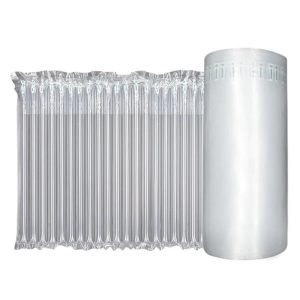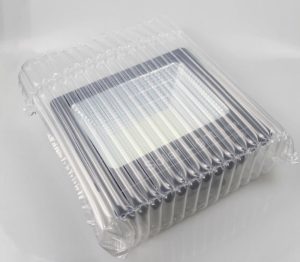
Air column bags are made of either linear low-density polyethylene (LLDPE) or nylon film. LLDPE are milky white particles featuring non-toxic, tastelessness, odorless ness, high tensile strength, and penetration resistance. And nylon is characterized by its wear resistance, heat resistance, and good resilience. Through extrusion coating or through co-extrusion, air-tight air columns are formed in a membrane-like way with a thickness of 0.06mm to 0.1mm and are then inflated when being used.
A single time of inflation is sufficient to fill all the columns of a bag. It adopts backstop valves to automatically lock the air inside each column. Each column forms an independent air chamber. When an air chamber is damaged, then only the damaged column fail partially. The rest of the columns will be completely unaffected and offer anti-seismic protection effectively. An air column bag is usually long-lasting without air leakage.
360-degree air cushioning protection can be customized according to the size of the product, which can minimize the likelihood of damage of items in the transportation process. Compared with traditional packaging materials, the item will be less likely to be damaged on account of too much space in the inner box of the package where the goods will often be displaced during the transportation process. Even be extrusion, air column bags’ close-fitting design can disperse pressure to avoid damage. Generally, an air column bag can withstand around 200kg.
What is the Use Value of Air Column Bag?

2. The manufacturing and processing of air column bags are extremely cost-effective thanks to the completely mechanized and automated production process. The manufacturing of air column bags are free from molding and saves significant research and development costs.
3. Air column bags are inflated manually before use and the amount of air to be inflated from the air inlet can be adjusted according to the size of the product to be packaged. Within its maximum inlet air limit, the product can be packaged in a close-fitting manner to prevent damage during transportation. Air column bags facilitate packaging as a small air pump like a domestic vacuum would suffice to inflate a large number of air column bags. Air column bags can significantly reduce packaging process, save manpower, save time, and improve packaging efficiency.
4. Air column bags boast a unique design that makes each column an independent air chamber with a check valve. Damage of a single column will not lead to the failure of the whole air column bag. The rest of the columns can remain intact and continue to provide the desired shockproof protection. An air column bag can effectively seal the air inside of the bag in 3-6 months after inflation.
Difference between Air Column Bags and Traditional Packaging Materials
The increasing popularity of air column bags is closely relevant to the rise of e-commerce and online retailing. It remains unknown as to when air column bags are firstly be used as packaging materials, however, their visibility and use have been ever-improving and have been used an alternative to traditional packaging materials like EPE foam, PES polystyrene, and paper-plastic materials. The chart below shows a set of comparisons between air column bags and traditional packaging materials.
| Packaging materials | Air Column Bags | EPE Foam | PES Polystyrene | Paper-plastic paper holder (Molding) |
| Appearance | An elegant and simple solution to significantly improve packaging appearance and corporate image | Ordinary appearance
Failure to improve the corporate image |
Potential adverse impacts on a company’s image | Ordinary appearance, Failure to Improve the Corporate Image |
| Price | Raw materials costs are slightly higher, while they save costs in warehousing and labor | Costly | Low cost while molding may cost much | Moderately cost-effective |
| Protection | Ideal cushioning performance for a wide range of items | Excellent cushioning performance | Rigid texture and poor cushioning performance, vulnerable to damage during transportation | Poor cushioning performance, unsuitable for heavy goods which are easily vulnerable to damage during transportation |
| Storage Costs | Flat before use requiring little storage | Huge in volume,
Consumption of huge warehousing costs |
Large in size incurring huge warehousing costs | Small volume |
| Environmental Protection | Environmentally friendly and recyclable | Large volume and high recovery cost | Unrecyclable, potential pollutants to the environment | Environmental protection, recyclable, but the paper-making process emits pollutants |
| Marketing Communication | Customized printing available | Customized printing not available | Customized printing not available | Customized printing not available |
Despite the above-mentioned advantages over other packaging materials, it should also be noted air column bags are, to some extent, similar to types that are subject to air leakage. Air leakage occurs either when the films of the air column bags are damaged or when the check valves used to seal the air chambers are sub-standard. Generally, air leak from the films and the check valves accounts for 20% and 80% respectively. The air leakage of an air column bag can be 15% yearly after being inflated, which is inevitable. For the purpose of the best cushioning performance, it is suggested to take the following steps when air column bags are being used.
- Duly increase the air pressure of the air column bags when inflating them. In practice, air pressure at 82.73kpa can effectively compensate for the potential leakage.
- Despite the fact that air chambers are sealed with check valves without needing extra sealing measures, it is suggested that sealing of the air inlets of air column bags be done to prevent the air column bags from air leakage. A sealing machine can help to achieve this end when air column bags are expected to function for over one year or to be used for multiple times.
- In the case of continuous or long-time use, air column bags are supposed to be inflated for a second time to maintain the best cushioning performance.














Leave a Reply